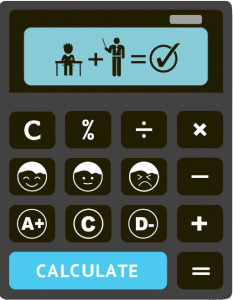Overview
You’ve already learned about exponents and exponential functions. It’s time to turn our attention to a related concept from your Year 11 HSC Advanced Maths syllabus – logarithms.
Learning Outcomes
Once you finish reading this page, you should
- Understand the relationship between exponents and logarithms
- Know how the graphs of logarithmic functions look like
- Know what function inverses are
- Be able to apply your knowledge of differentiation to find the derivatives of logarithmic functions
What is a logarithm?
A logarithm is just another way to write an exponential relation, as mentioned here. Here are some examples:
\(log_{2}32=5\) (because \( 2^{5}=32\))
\(log_{3}81=4\) (because \( 3^{4}=81\))
\( log_{4}\frac{1}{16}=-2 \) (because \( 4^{-2}=\frac{1}{16} \))
The number at the bottom is called the base. So, the last one is read as “log base 4 of 1/16 is -2”.
When the base of a logarithm is e, Euler’s Number, we write it as ln (without a base). So, \( ln5=log_{e}5, ln10=log_{e}10,\) and so on.
Notice that logarithms can be positive or negative. Can it be also 0? When is the logarithm of a number equal to 1? Think!
Laws of Logarithms
Exponents and logarithms are closely related. They are inverses of one another. As of now, you can think of the term ‘inverse’ as the same as ‘opposite’. It does have a deeper implication, though, which we shall explore in a bit.
If there are laws of exponents, there must be laws of logarithms, too.
Graphs of Logarithmic Functions
We’ve already seen here what the graphs of exponential functions look like. Let’s focus on the graph of \( y=e^{x}\) and \( y=lnx\), as shown in the figure below.
Notice how each graph is the reflection of the other one about the graph of the line y = x. Such functions that are reflections of one another about the line y = x are called inverses of one another.
If a function g(x) is the inverse of a function f(x), each point (x, y) on f(x) is reflected over the line y = x to render the point (y, x).
Take, for example the functions \( y=e^{x}\) and \( y=lnx\), as shown in the figure above. (0, 1) is a point on \( y=e^{x}\). It gets reflected to (1, 0) on \( y=lnx\).
How about the graph of \(y=log_{10}x\)? To graph this function, use your knowledge of exponents to first come up with the graph of \( y=10^{x}\). Then, reflect it over the line y = x, as shown in the figure below.
If you want to know how to find the equation of a function’s inverse algebraically, check out this article.
Derivatives of Logarithmic Functions
The derivative of the function \(f(x)=lnx\) is \( \frac{1}{x}\). We can write this as \( \frac{d(lnx)}{dx}=\frac{1}{x}\). What if the base is not e? Here goes the formula:
\( \frac{d(log_{a}x)}{dx}=\frac{1}{x(lna)}\).
For more complex functions, you can apply the product, quotient or chain rule.
Example 1:
Find \(\frac{d[xln(x^{2}+1)]}{dx}\).
Solution:
As the given function is a product of two different functions – \(x\) and \( \ln(x^{2}+1)\), we need to use the product rule here.
Again, to differentiate \( \ln(x^{2}+1) \), we need to use the chain rule. Here we go…
\(\frac{d[xln(x^{2}+1)]}{dx} \)\(=x\frac{d[ln(x^{2}+1)]}{dx}+ln(x^{2}+1)\frac{d(x)}{dx}\)
To find \(\frac{d[ln(x^{2}+1)]}{dx}\), we let \( x^{2}+1=u\) and apply the chain rule as follows:
\(\frac{d(lnu)}{dx}=\frac{d(lnu)}{du}\times \frac{du}{dx}=\frac{1}{u}\frac{du}{dx}\)
Substituting for u, we have
\(\frac{d[ln(x^{2}+1)]}{dx}=\frac{1}{(x^{2}+1)}\times 2x=\frac{2x}{x^{2}+1}\).
Therefore,
\( \frac{d[xln(x^{2}+1)]}{dx}=x\times \frac{2x}{(x^{2}+1)}+ln(x^{2}+1)\times 1\)\( =\frac{2x^{2}}{(x^{2}+1)}+ln(x^{2}+1)\).
Example 2:
If \(f(x)=\sqrt{lnx}\), find \( f'(x)\).
Solution:
Again, we let \( ln(x)=u\) and apply the chain rule.
\(f'(x)=\frac{d(\sqrt{lnx})}{dx}\).
As we let \( lnx=u\), we need to find \( \frac{d(\sqrt{u})}{dx}=\frac{d(\sqrt{u})}{du}\times \frac{du}{dx}\)\(=\frac{d(u^{\frac{1}{2}})}{du}\times \frac{du}{dx}\)\(=\frac{1}{2}u^{-\frac{1}{2}}\times \frac{du}{dx}\)\(=\frac{1}{2\sqrt{u}}\times \frac{du}{dx}\)\(=\frac{1}{2\sqrt{lnx}}\times \frac{1}{x}\)\(=\frac{1}{2x\sqrt{lnx}}\)
Wrap Up
Logarithmic functions are important in real-life situations where rapidly changing quantities must be expressed and measured. For example, logarithms come in handy when calculating population growth, comparing earthquake magnitude and measuring sound intensity. If you need more help understanding logarithmic functions and their applications, don’t hesitate to contact us.








